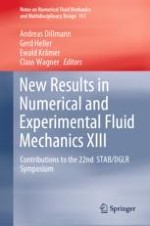2021 | Book
New Results in Numerical and Experimental Fluid Mechanics XIII
Contributions to the 22nd STAB/DGLR Symposium
Editors: Prof. Dr. Dr. Andreas Dillmann, Dr. Gerd Heller, Prof. Dr. Ewald Krämer, Prof. Dr. Claus Wagner
Publisher: Springer International Publishing
Book Series : Notes on Numerical Fluid Mechanics and Multidisciplinary Design
